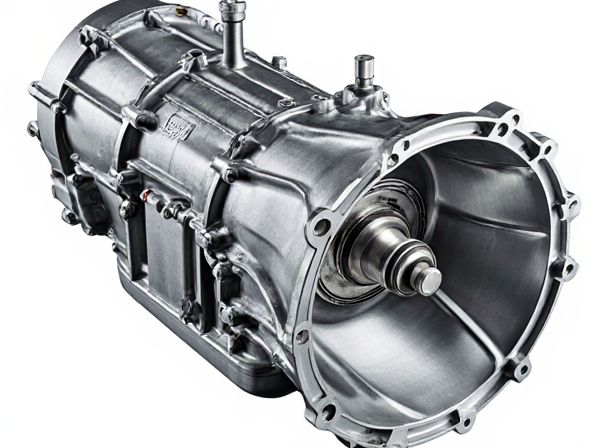
Photo illustration: Sequential manual vs Synchromesh manual
Sequential manual transmissions allow rapid gear changes through a linear shift pattern, ideal for performance driving, while synchromesh manuals use synchronizers to match gear speeds for smoother, more precise shifts. You benefit from quicker shifts with a sequential box, but synchromesh provides better everyday drivability and less wear on components. Choosing between the two depends on whether your priority is speed or comfort during gear changes.
Table of Comparison
| Feature | Sequential Manual Transmission | Synchromesh Manual Transmission |
|---|---|---|
| Shifting Mechanism | Linear, gear selection in sequence (up/down) | H-pattern shifting with synchronized gears |
| Shift Speed | Fast, immediate gear changes | Slower, requires clutch and precise timing |
| Usability | Primarily race-focused, less intuitive for daily use | Common in everyday vehicles, user-friendly |
| Gear Engagement | Direct engagement, no skipping gears | Can skip gears, requires synchronizers |
| Maintenance | Higher maintenance due to mechanical complexity | Lower maintenance, widely available parts |
| Cost | Generally more expensive | More affordable and repairable |
| Driving Experience | Smoother, faster shifts, ideal for sport driving | Engaging manual control, preferred for casual driving |
Introduction to Manual Transmission Types
Sequential manual transmissions allow gear changes in a fixed order using a lever or paddle, optimizing rapid shifts for performance vehicles by minimizing shift time. Synchromesh manual transmissions employ synchronizer rings to match gear speeds for smooth, frictionless gear engagement, making them ideal for daily driving with ease and durability. Both types serve different driving needs, with sequential systems favored in racing and synchromesh common in everyday passenger cars.
What Is a Synchromesh Manual Transmission?
A synchromesh manual transmission utilizes synchronizer rings to match gear speeds before engagement, enabling smooth and grind-free shifting. Unlike sequential manuals that require shifting through gears in order without skipping, synchromesh allows the driver to select any gear directly. This design enhances driving comfort and reduces wear by synchronizing gear and shaft speeds during gear changes.
What Is a Sequential Manual Transmission?
A sequential manual transmission enables gear changes in a fixed order, allowing rapid shifts by pushing or pulling a lever without the need to manually engage a clutch for each gear. Commonly found in motorcycles and racing vehicles, this system enhances shifting speed and precision compared to traditional H-pattern manuals. Unlike synchromesh manuals, which use synchronizer rings to match gear speeds for smooth gear engagement, sequential manuals rely on a ratchet mechanism to control gear selection sequentially.
Key Structural Differences
Sequential manual transmissions feature a dog clutch system allowing gear changes by pushing or pulling a lever through a fixed gate, enabling rapid, precise shifts without the need for a traditional H-pattern. Synchromesh manuals use synchronizer rings to match gear speeds before engagement, facilitating smoother and quieter shifts but requiring more steps to change gears. Structurally, sequential gearboxes rely on a selector drum and forks for gear engagement, whereas synchromesh designs use sliding sleeves and synchronizers to align gear speeds before engagement.
Gear Shifting Mechanisms Compared
Sequential manual transmissions use a ratchet mechanism enabling gear shifts in a fixed order, allowing faster, more consistent gear changes often favored in racing applications. Synchromesh manuals incorporate synchronizer rings that match gear speeds before engagement, ensuring smoother and quieter shifts for everyday driving comfort. The fundamental difference lies in gear selection method: sequential systems shift gears linearly, while synchromesh systems allow direct access to any gear, balancing speed with drivability.
Performance and Speed Considerations
Sequential manual transmissions offer faster gear changes by allowing drivers to shift gears in a linear sequence without the need for clutch use during shifts, enhancing performance in high-speed driving and racing scenarios. Synchromesh manuals provide smoother engagement between gears through synchronizer rings that match gear speeds, improving drivability and reducing wear at lower speeds but resulting in slightly slower shift times compared to sequential systems. Performance-focused applications prioritize sequential manuals for their quick shift capability and minimal interruption in power delivery, while synchromesh manuals balance usability and speed for everyday driving conditions.
Driver Experience and Usability
Sequential manual transmissions provide a more direct and faster gear-shifting experience, enhancing driver engagement and control, especially in sports or performance driving. Synchromesh manual transmissions offer smoother gear changes with less driver effort, making them more user-friendly and ideal for everyday driving scenarios. The choice between the two impacts driving dynamics: sequential manuals favor precision and speed, while synchromesh prioritize ease and comfort.
Reliability and Maintenance Needs
Sequential manual transmissions offer higher reliability due to fewer moving parts and simpler gear engagement, reducing the likelihood of mechanical failure and lowering maintenance frequency. Synchromesh manuals require regular clutch and synchronization adjustments to maintain smooth shifting and prevent gear wear, leading to more frequent maintenance needs. The durability of sequential manuals particularly benefits high-performance or racing vehicles, while synchromesh transmissions suit everyday driving with manageable upkeep.
Typical Applications and Use Cases
Sequential manual transmissions are commonly used in high-performance motorcycles, rally cars, and race vehicles where rapid gear changes and minimal shift times are crucial for maintaining speed and control. Synchromesh manual transmissions dominate passenger cars, light trucks, and everyday vehicles, providing smooth gear transitions and ease of use for drivers through synchronized gear engagement. Industrial machinery and heavy-duty trucks may employ robust synchromesh systems tailored for durability and load control in varied operational environments.
Choosing the Right Manual Transmission
Choosing the right manual transmission depends on driving style and vehicle use, with sequential manuals offering faster gear shifts ideal for racing and performance applications. Synchromesh manuals provide smoother, more forgiving gear changes suited for everyday driving and improved drivability. Understanding the mechanical differences and intended use cases ensures optimal performance and comfort in vehicle operation.
 caratoz.com
caratoz.com